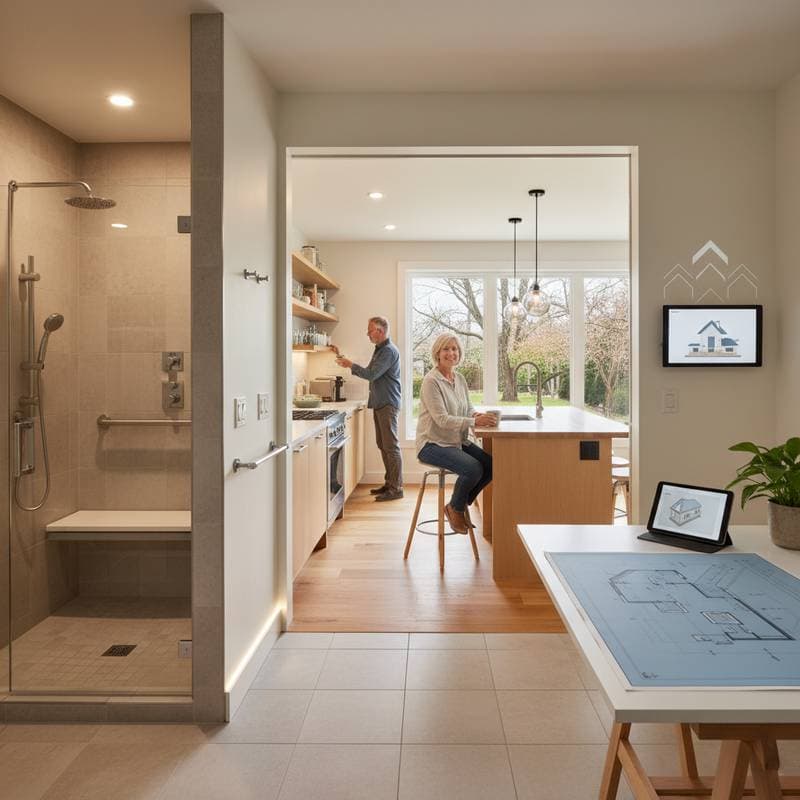Stay Independent: 2025 Aging-in-Place Renovation Wins
Quick Cost Summary
Aging-in-place renovations range from $6,000 to $80,000, with an average of $35,000 for a comprehensive home accessibility update. Smaller enhancements, such as installing grab bars, lever handles, or improved lighting, start at $500 to $2,500. Larger projects, including accessible bathrooms, stair lifts, or kitchen modifications, often cost $20,000 to $50,000 or higher.
Key factors influencing costs include the scope of the work, whether it involves a single room or the entire home; labor expenses for licensed contractors, electricians, and plumbers; materials like walk-in tubs, non-slip flooring, and widened doors; design complexity, especially if structural alterations are required; and local labor rates plus permit fees.
Highlights and Key Insights
Comprehensive accessibility upgrades for the whole home average $35,000, yet targeting essential safety features can limit expenses to under $10,000. Bathroom remodeling ranks as the priciest aging-in-place initiative, typically ranging from $15,000 to $25,000. Kitchen adaptations designed for independence cost $10,000 to $30,000 on average.
Labor accounts for 50 to 60 percent of the total budget. Safety-focused modifications frequently boost property value and cut down on future healthcare expenses.
Contractor Costs and Professional Versus DIY Options
Professional installers bill $60 to $120 per hour, varying by trade and region. For intricate tasks like bathroom conversions or electrical upgrades, engaging licensed experts ensures safety and adherence to building codes.
Individuals can manage DIY efforts on straightforward projects, including:
- Mounting grab bars or lever handles
- Swapping knobs for rocker switches
- Incorporating motion-sensor lighting
Such endeavors require $100 to $500 in materials and several hours of effort. Attempting DIY on electrical or plumbing elements risks code infractions and hazards without proper expertise.
Selecting professionals guarantees correct execution and often comes with warranties that safeguard the investment.
Strategies to Reduce Expenses
Prioritize High-Impact Safety Measures
Concentrate on upgrades that deliver strong safety gains, such as grab bars, slip-resistant flooring, and enhanced lighting. These changes provide instant protection at a modest price point.
Combine Multiple Projects
Grouping bathroom and hallway modifications into a single contract minimizes redundant labor and yields savings of 10 to 15 percent on overall costs.
Select Durable Mid-Range Materials
Opt for reliable mid-grade options that offer performance without premium pricing. For instance, vinyl plank flooring delivers a secure, non-slip surface at approximately half the expense of ceramic tile.
Explore Financial Support Options
Various programs provide grants or low-interest loans for accessibility improvements. Certain utility providers and local housing authorities offer rebates on energy-efficient lighting or smart home devices that promote independence.
Basis for Cost Estimates
These figures derive from contractor quotations, national remodeling surveys, and current building supply prices. Averages encompass both labor and materials for standard mid-range initiatives. Regional differences and labor shortages may adjust totals by up to 20 percent.
Room-Specific Cost Details
Bathroom Enhancements
Bathrooms pose the greatest slip and fall dangers, positioning them as a primary focus for renovations.
- Basic accessibility additions: $8,000 to $12,000, covering grab bars, superior lighting, and slip-resistant flooring.
- Complete remodel: $15,000 to $25,000, featuring walk-in tubs or curbless showers, broader entries, and adjustable vanities.
- Premium accessible design: $30,000 and above, incorporating seamless tiling, bespoke cabinetry, and sophisticated fixtures.
Kitchen Adaptations
Thoughtful kitchen designs foster ongoing independence.
- Simple enhancements: $5,000 to $10,000 for pull-out shelves, lever faucets, and optimized lighting.
- Extensive remodel: $20,000 to $30,000, including lowered counters, wall-mounted ovens, and open layouts.
Entryways and Hallways
- Ramps: $2,000 to $6,000, based on material and length.
- Widened doorways: $500 to $1,200 per unit, including frames and trim.
- Hallway lighting and flooring: $1,000 to $3,000 for sensor-based lights and non-slip materials.
Bedrooms and Living Spaces
- Flooring updates: $3 to $7 per square foot for slip-resistant options.
- Lighting and outlet modifications: $500 to $2,000.
- Smart home integrations: $1,000 to $3,000 for voice-activated lighting and thermostats.
Enduring Advantages
Aging-in-place renovations extend beyond accessibility to diminish fall risks, decrease prospective care costs, and cultivate inviting spaces for guests across generations. Families often implement these changes proactively to sidestep hasty updates following health shifts.
Properties equipped with universal design principles sustain independence over many years. Such homes enable residents to stay rooted in their communities and preserve social ties.
Preserving Renovation Value
Regular upkeep after completion safeguards safety and longevity.
- Examine grab bars and handrails every few months for stability.
- Verify lighting systems and sensors function reliably.
- Clean non-slip surfaces routinely to maintain grip.
- Arrange inspections for altered plumbing and electrical components.
Proactive care ensures the home remains secure and prolongs the effectiveness of upgrades.
Frequently Asked Questions
How much does an aging-in-place renovation cost?
Homeowners typically invest $6,000 to $80,000, contingent on project scale and selections. The national average stands at $35,000 for a full-home overhaul.
What constitutes the priciest element of aging-in-place remodeling?
Bathrooms generally demand the highest outlay due to plumbing, waterproofing, and structural demands.
Is it feasible to perform certain tasks independently?
Yes, individuals may tackle installations like grab bars, lever handles, and lighting. Professionals handle plumbing, electrical, or structural alterations.
Do these renovations elevate home value?
Yes, accessibility features commonly enhance worth and broaden buyer appeal. They also offset assisted living expenses.
Are permits necessary?
Permits apply to plumbing, electrical, and structural modifications. Consult the local building authority prior to commencement.
Planning Your Renovation
Begin with an evaluation of rooms posing the greatest safety concerns, prioritizing bathrooms, entryways, and lighting. Obtain estimates from at least two certified contractors, evaluating scope, pricing, and guarantees.
If budget constraints arise, proceed in stages, initiating with modest changes and building upon them as requirements develop. Each step contributes to greater comfort, security, and sustained independence.
A strategically executed aging-in-place renovation delivers lasting freedom, protection, and reassurance.











